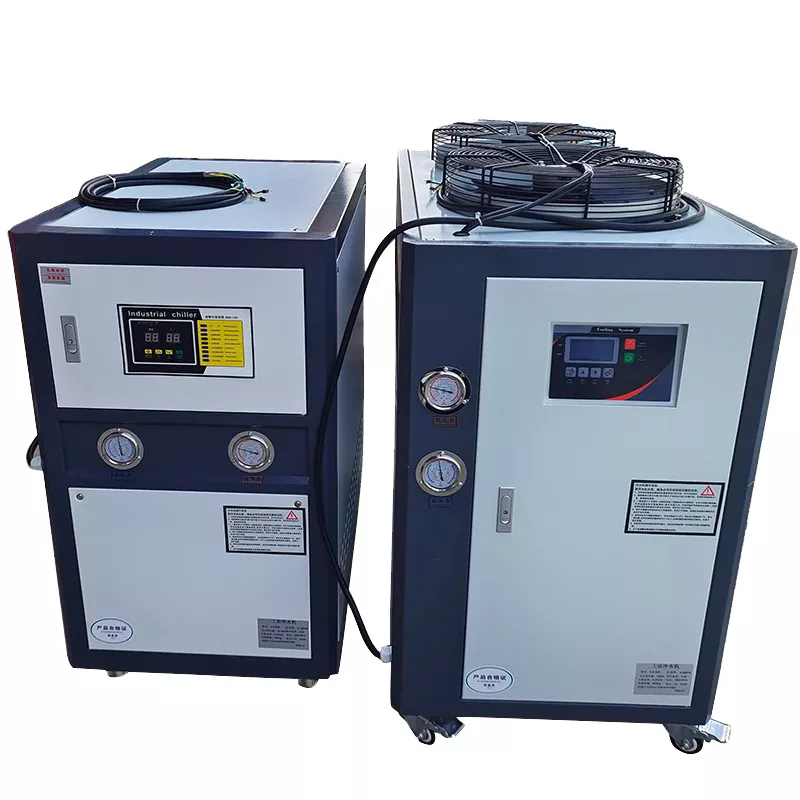How Does a Machine Chiller Optimize Industrial Equipment Performance?
2025-08-11
In industrial settings, where machinery operates continuously under high loads, maintaining optimal temperatures is critical to ensuring efficiency, reliability, and longevity. Machine chillers have emerged as vital components in these environments, regulating heat levels to prevent overheating, reduce wear, and maintain consistent performance. As industries strive to maximize productivity and minimize downtime, understanding how machine chillers work and why they are essential has become a key priority. This guide explores the role of machine chillers in industrial operations, their operational mechanisms, detailed specifications of our top-performing models, and answers to common questions to highlight their impact on equipment performance and business outcomes.
Trending News Headlines: Top Searches on Machine Chillers
- "How Water-Cooled Chillers Reduce Downtime in CNC Machining"
- "Machine Chiller Maintenance: Key Tips for Extended Lifespan"
These headlines underscore the key concerns of industrial operators: energy efficiency, downtime reduction, and maintenance best practices. For businesses seeking to invest in cooling solutions, these trends provide valuable insights into the features and practices that deliver the best results.
Why Machine Chillers Are Critical for Industrial Equipment
Preventing Overheating and Equipment Failure
Industrial machinery, such as CNC machines, laser cutters, injection molding equipment, and hydraulic systems, generates significant heat during operation. Without proper cooling, this heat can accumulate, leading to overheating, component failure, and unplanned downtime. For example, overheating in CNC machines can cause thermal expansion of metal parts, leading to inaccuracies in machining and product defects. Machine chillers circulate cooled fluid (water or a water-glycol mixture) through the equipment, absorbing excess heat and maintaining temperatures within optimal ranges. This prevents overheating, reduces the risk of breakdowns, and ensures machinery operates reliably even during extended use.
Enhancing Precision and Product Quality
Many industrial processes require tight temperature control to maintain precision. For instance, in plastic injection molding, consistent temperatures are critical to ensuring uniform part quality and reducing defects like warping or shrinkage. In laser cutting, overheating can affect beam stability, leading to uneven cuts and poor finish quality. Machine chillers provide precise temperature regulation, keeping fluid temperatures within ±1°C (or tighter ranges for specialized models), which translates to consistent equipment performance and higher product quality. This not only reduces waste from defective products but also enhances a company’s reputation for reliability.
Extending Equipment Lifespan
Heat is a major contributor to wear and tear in machinery. High temperatures accelerate the degradation of lubricants, seals, and electrical components, leading to premature failure and the need for frequent repairs or replacements. By maintaining optimal operating temperatures, machine chillers reduce thermal stress on components, slowing down wear and extending equipment lifespan. This lowers long-term maintenance costs and reduces the need for capital expenditures on new machinery, delivering significant cost savings over time.
Reducing Energy Consumption
While machine chillers consume energy to operate, they can actually reduce overall energy usage in industrial facilities. Overheated equipment often works harder to maintain performance, consuming more power. For example, a CNC machine struggling with heat buildup may require additional energy to compensate for inefficiencies. By keeping equipment cool, chillers ensure it operates at peak efficiency, reducing energy consumption. Additionally, modern energy-efficient chillers incorporate features like variable-speed compressors and smart controls, which adjust cooling output based on demand, further lowering energy usage and operational costs.
Ensuring Regulatory Compliance
In some industries, such as pharmaceuticals and food processing, strict regulations govern equipment temperatures to ensure product safety and quality. For example, cooling systems in pharmaceutical manufacturing must maintain specific temperatures to prevent spoilage of sensitive materials or ensure compliance with Good Manufacturing Practices (GMP). Machine chillers with precise temperature controls and monitoring capabilities help businesses meet these regulatory requirements, avoiding fines and ensuring compliance with industry standards.
How Machine Chillers Work
Heat Absorption
Chilled fluid (typically water or a water-glycol mixture) is pumped through hoses or pipes to the industrial equipment, where it absorbs heat generated during operation. The heated fluid then returns to the chiller for cooling.
Refrigeration Cycle
Inside the chiller, the heated fluid passes through a heat exchanger, where it transfers heat to a refrigerant. The refrigerant undergoes a phase change (from liquid to gas) as it absorbs heat, which is then compressed by a compressor to increase its temperature and pressure.
Heat Dissipation
In air-cooled chillers, the compressed refrigerant flows through condenser coils, where fans blow ambient air over the coils, dissipating heat into the environment and causing the refrigerant to condense back into a liquid. In water-cooled chillers, the refrigerant transfers heat to a separate water loop, which is then cooled by a cooling tower or other water source.
Recirculation
The cooled refrigerant flows through an expansion valve, reducing its pressure and temperature, before returning to the heat exchanger to repeat the cycle. The now-cooled fluid is pumped back to the industrial equipment to absorb more heat, completing the loop.
Our Machine Chiller Specifications
|
Feature
|
CompactCool MC-10 (For Small Equipment)
|
IndustrialPro MC-50 (For Medium Machinery)
|
HeavyDuty MC-100 (For Large-Scale Operations)
|
|
Cooling Capacity
|
10 kW (2.8 tons)
|
50 kW (14.2 tons)
|
100 kW (28.4 tons)
|
|
Temperature Control Range
|
5–35°C
|
5–30°C
|
0–25°C
|
|
Temperature Stability
|
±1°C
|
±0.5°C
|
±0.1°C
|
|
Refrigerant
|
R410A (environmentally friendly)
|
R410A
|
R134a (low GWP)
|
|
Cooling Medium
|
Water or 30% glycol-water mixture
|
Water or 50% glycol-water mixture
|
Water or 60% glycol-water mixture
|
|
Pump Flow Rate
|
15 L/min
|
80 L/min
|
160 L/min
|
|
Pump Pressure
|
3 bar
|
5 bar
|
7 bar
|
|
Tank Capacity
|
20 L
|
80 L
|
200 L
|
|
Power Supply
|
220V/50Hz, 1-phase
|
380V/50Hz, 3-phase
|
380V/50Hz, 3-phase
|
|
Compressor Type
|
Scroll
|
Scroll (twin)
|
Screw (semi-hermetic)
|
|
Cooling Type
|
Air-cooled
|
Air-cooled or water-cooled (optional)
|
Water-cooled
|
|
Dimensions (L x W x H)
|
600 x 450 x 750 mm
|
1200 x 800 x 1100 mm
|
2000 x 1200 x 1800 mm
|
|
Weight
|
120 kg
|
450 kg
|
1200 kg
|
|
Noise Level
|
≤ 65 dB
|
≤ 72 dB
|
≤ 80 dB (with optional soundproofing)
|
|
Control System
|
Digital thermostat with LED display
|
PLC control with touchscreen, remote monitoring
|
PLC control with HMI, IoT connectivity, auto-adaptive cooling
|
|
Safety Features
|
Overheat protection, low alarm, compressor overload protection
|
Overheat protection, low/high pressure alarm, flow sensor, phase protection
|
Overheat protection, low/high pressure alarm, flow sensor, phase protection, leak detection
|
|
Suitable Applications
|
Small CNC machines, laser markers, laboratory equipment
|
Injection molding machines, medium CNC centers, hydraulic systems
|
Large injection molding lines, metal processing plants, industrial refrigeration
|
|
Compliance
|
CE, RoHS
|
CE, ISO 9001, RoHS
|
CE, ISO 9001, ISO 14001, RoHS
|
All our machine chillers are built with high-quality components, including corrosion-resistant tanks, efficient compressors, and durable pumps, ensuring long-term reliability even in harsh industrial conditions. They undergo rigorous testing to meet international standards, including CE and ISO certifications, making them suitable for global markets. We also offer customization options, such as low-temperature configurations, explosion-proof designs, or integrated filtration systems, to meet specific industry requirements.
FAQ: Common Questions About Machine Chillers



